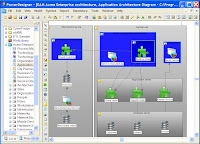While i have been in software programming for years, there has never been a real well stated framework that i have had to follow down at the implementation level. How many other programmers are like that? Code and Fix is what i ahve been doing for two decades now...
In the last three years I have started managing more than programming, and leading out some of the PowerDesigner initiatives has really opened my eyes to a different world.
Who knows what a framework is?
*programmer responds*Something to waste my time.
*project lead responds*Something to make my programmers document what they are doing.
*IT Director responds*A Tool for structuring deliverables that helps me show the business we are accomplishing their requests.
*Business user responds*A set of documents I can help IT create that lets me help inform them of what I want to help with my job.
*Executive Leader responds*This is going to cost a lot of money, so there better be some ROI.
In the end, a framework, like Zachman, or DoDAF, is a list of artifacts that a team has to produce in the efforts to create a new software system. If that team completes all of the documentation, models and spreadsheets, the system will be far easier to create and maintain. Now that I have experienced this from a Department of Defense Architecture Framework perspective, I know this is only partially true. Fulfilling the proper artifacts is the key. As the architect on this latest project, there were over 20 models that needed to be created. What i found was a huge redundancy between models, so the majority of them will never be used. So why did I complete them? To be compliant with the Government requriment that we completed all artifacts for DoDAF and a computere system for message handling. Oh well, we are paid by the hour times the weight of paper used...
So, why did our framework implementation produce a bunch of extra stuff... Because DoDAF is an implementation framework with very little guidance on exactly what i needed to methodically produce a required result. Methodology is a key ingredient to how we act on a framework. The really sad part is that most methodology's do not encompass a software development life cycle. In our project, we found that the programmers were steaming ahead full tilt while we were reverse engineering their classes and database with team meetings to create process maps. What a waste of time. If we had spent the first few weeks creating the process flows, data flows, application architectures, physical database diagrams, etc... this project would have take a two, maybe three months, rather than six months. Is this a result of hourly based consulting? I am starting to wonder...
hopefully this little chat is worth reading...

